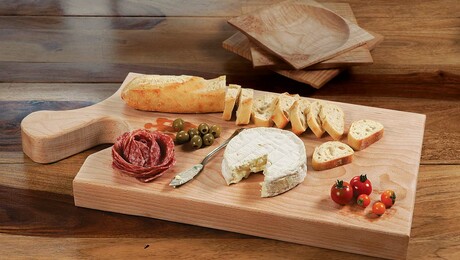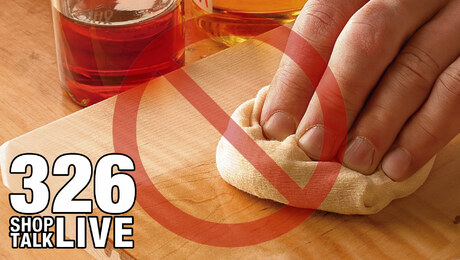All About Choosing a Finish

After speaking with hundreds of woodworkers over the span of many years, one thing is crystal clear to me: Applying a finish to furniture and cabinetwork represents the biggest headache to most woodworkers. Many accomplished woodworkers spend countless hours building what is sometimes museum-quality work — designing the piece to the proper scale, milling the lumber to size, executing complicated joinery techniques, even carving intricate details — and then when they’re ready to apply a finish, they freeze up with fear.
But a worse problem than being panic-stricken about applying a finish happens when you blithely forge on, slopping on a bad finish without looking at the results with a critical eye. Nothing can more readily ruin a project. To choose which finish you want to use on any given job, ask yourself a series of questions.
The Basics
• What type of project is it?
• Does the finish need to resist water, scuffing, and abrasion?
• Should the finish be easy to repair?
• Color — is an amber or “water-white” tone preferable?
• Do you want a deep, lustrous, filled, and polished surface?
• Does the amount of time it takes to apply a finish matter?
• Evaporative vs. reactive
Why do so many woodworkers dread finishing? I’m convinced that the reasons are twofold. First, some finishes are highly complicated chemical formulas, and the contents are not always listed on the labels. Manufacturers employ chemists with doctoral degrees to research and develop their products. This can make people feel like they have to be an expert on hydrocarbons to be able to put a good finish on a woodworking project. Second — and perhaps more important — early on in their hobbies or careers, woodworkers tend to find one finish they prefer and stick with it.
Learning how to lay on a finish is like riding a bicycle or playing golf — there’s a learning curve involved with the process, and the more you do it, the more skilled you become. The best approach to learning how to apply a new finish is to practice on scraps of lumber or plywood. Experiment with a new technique until you get it down pat. The results can be immensely rewarding, both for you and for the quality of your future projects.
What type of project is it?
An 18th-century reproduction demands a different finish from a set of new kitchen cabinets, or a keepsake box, or the wood frame of a mostly modern upholstered chair. Most of the priceless furniture in museums was finished with either shellac or an oil-based varnish, and the surfaces of tabletops were often filled and highly polished. And chances are that the museum furniture has been refinished and coated with wax several times over its lifespan. If you’ve built a set of new kitchen cabinets, you’ll want the most durable finish you can find, to withstand the daily onslaught of grease-laden air and chemicals in foodstuffs and cleansers. It’s no accident that most kitchen-cabinet manufacturers use catalyzed lacquers or conversion varnishes. For a simple keepsake box, it’s hard to beat the natural looking beauty of an oiled surface. And for a project such as the wood frame of a contemporary chair, the choice is wide open: You don’t have any concerns about being historically correct in your choice, nor is durability much of an issue.
Does the finish need to resist water, scuffing and abrasion?
If so, shellac, plain oil finishes, and waxes would not work. To varying degrees, they scratch easily and do not hold up well to the threat of moisture absorption. Most oil- and water-based varnishes and polyurethanes, catalyzed lacquers, and conversion varnishes do a much better job protecting the surface of wood.
Should the finish be easy to repair?
Wood finishes vary greatly in how easy they are to fix when something goes wrong. In general, the easier a finish is to apply, the easier it will be to repair. Straight oil finishes are a good example. If the surface is lightly scratched or marred by a water stain, simply sand down or scrape the surface clean, and then apply a new coat of oil. The same applies to waxed surfaces — applying and rubbing out a new coat of wax will often make the surface look like new. This is not the case with many varnishes (including polyurethane) and more modern catalyzed finishes. By sanding the surface, you risk going through the very top coat, or more, and you’re left with what are often called “witness lines,” which means you’ve gone all the way through the layers of film. When that happens, it’s sometimes not possible to fix the mess without removing all of the finish and starting over.
Color — is an amber or “water-white” tone preferable?
All finishes, including simple oils, change the color of the wood at least somewhat, and some do more than that, giving it a slightly darker hue. Most film finishes, such as shellac and varnish, impart an amber tone, often considered desirable for the warm tones that it leaves on the wood surface. Indeed, various grades of shellac are sold and used strictly for their color. But if your goal is to avoid an amber color, you can use nitrocellulose and acrylic lacquers that are sold for that purpose — they are often characterized as being “water-white.”
Do you want a deep, lustrous, filled, and polished surface?
Traditionally, on tabletops and, for instance, the crotch-veneered surface on the doors of a breakfront cabinet or a clock case, the open-grain surfaces of the wood are filled and polished. Fillers should be used sparingly, but when properly applied, the effect is nothing short of stunning. When you hear mention of a French polish finish, that’s often what is meant, but you can get the same results with other, less laborious techniques. Either way, a filled and polished surface will require a lot more labor and time.
Does the amount of time it takes to apply a finish matter?
To professional cabinetmakers, time is money, and it pays to get the job done quickly. For that reason, professional shops often use quick-drying finishes, such as lacquer and shellac, because they can easily apply four coats in a day. They also tend to use spray equipment that can lay on a finish faster than you can with a brush or a wiping rag. But some people enjoy the slow, deliberate pace of building a brushed varnish finish. When you’re putting a finish on wood, patience really can be a virtue that you learn to appreciate, especially when the resulting finish proves it.
Evaporative vs. reactive
Not long ago, finishes were categorized as either film finishes or penetrating finishes. The problem with these two groupings was that the overlap between them caused confusion. For example, true oils, such as linseed and tung oil, were classified as penetrating finishes because they soak into the surface of the wood before they harden. That’s true, but if you keep applying additional coats of either of these oils, they eventually will develop what could easily be characterized as a layer of film. And oil-based varnishes dry to a hardened layer of film, but also contain oils that penetrate the wood fibers before the film forms. Nowadays, the finishes are categorized as evaporative or reactive, according to how they cure. It’s a slightly more exacting view of the differences among the myriad finishes available, though it’s still a less-than-perfect way to consider those differences.
Fine Woodworking Recommended Products

Odie's Oil

Foam Brushes

Diablo ‘SandNet’ Sanding Discs





















Log in or create an account to post a comment.
Sign up Log in